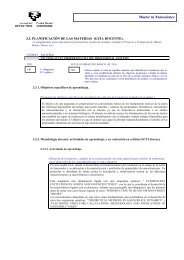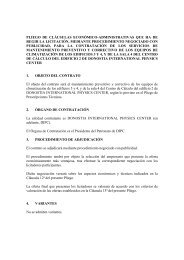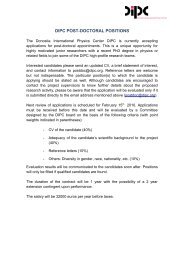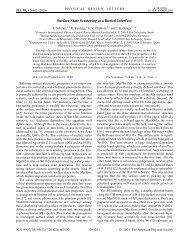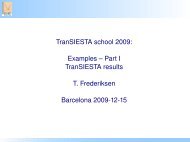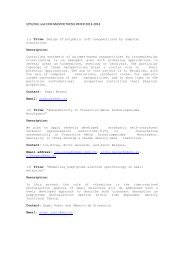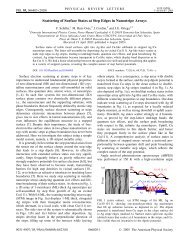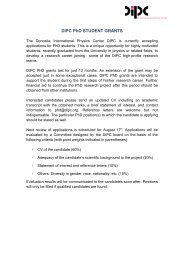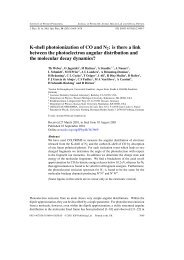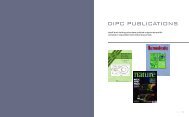Complete report - Donostia International Physics Center - Euskal ...
Complete report - Donostia International Physics Center - Euskal ...
Complete report - Donostia International Physics Center - Euskal ...
You also want an ePaper? Increase the reach of your titles
YUMPU automatically turns print PDFs into web optimized ePapers that Google loves.
2011 DIPC Highlight<br />
Quantum plasmon tsunami<br />
on a Fermi sea<br />
Lucas, G. Benedek, M. Sunjic, and P.M. Echenique<br />
New Journal of <strong>Physics</strong> 13, 013034 (2011)<br />
A highly charged ion flying-by a fullerene molecule violently strips away one of its valence electrons<br />
leaving behind a plasmon quantum tsunami, consisting in a coherent state of excitations<br />
of the charge density. The electron transfer confers an energy gain to the ion minus the energy<br />
required to excite the plasmon coherent states. By explaining a 15-years-old conundrum raised<br />
by state-of-the-art scattering experiments, a team of researchers from DIPC and the Universities<br />
of Namur, Milano-Bicocca and Zagreb suggest a new tool to investigate energetic collective excitations<br />
in nanostructures.<br />
A beam of energetic, highly charged Ar q+ ions is sent through a dilute C 60 fullerene vapor. An ion, which<br />
happens to pass by a neutral molecule, strongly polarizes it to the point where it may capture one or several<br />
electrons which land onto the ion discrete Rydberg states (Figure). The electronic potential energy released<br />
by the charge transfer causes an increase of the ion kinetic energy: Some understanding of the<br />
basis of the mechanism was already pointed out some years ago however, the highly unexpected shape<br />
of the measured energy gain distributions could not find a straightforward explanation. The gain curves<br />
extend smoothly to very high energies and are topped, from beginning to end, by series of small oscillations<br />
of 6 eV period (see Figure inset (a)), which evidently bear very little relation to the underlying set of<br />
discrete ion Rydberg levels. The work summarized here demonstrates that the discrete Rydberg spectrum<br />
is the due to the occurrence of a plasmon tsunami on the molecule. This consists of a violent rearrangement<br />
of valence electrons around the positive hole left behind on C 60 by the fast electron transfer. Charge<br />
density waves rush to screen the naked positive hole as it suddenly appears. This causes multiple plasmon<br />
excitations whose energy quanta are provided by the ion kinetic energy. The electrons always land on Rydberg<br />
levels but the energy liberated is apportioned between the ion kinetic energy increase and creations<br />
of plasmons. Thus the intensity of the kinetic energy gain peak, expected to appear at the nominal position<br />
of a Rydberg level, is in fact redistributed over a Poissonian series of plasmon peaks (hence the oscillations)<br />
extending on the loss side of the level.<br />
The theory developed in this work convincingly accounts for the observed spectra for all momenta q, as<br />
shown in the Figure inset (b). The phenomenon is a real electrodynamical quantum tsunami on the molecule<br />
which rings like a bell whenever one or several of its electrons are stripped away by the ion. The experimental<br />
method of highly charged ion energy gain spectroscopy, supported by the new understanding<br />
of the present theory, offers a novel opportunity to investigate collective excitations in a variety of nanostructures<br />
such as large molecules, atomic clusters or solid surfaces.<br />
A highly-charged argon ion, e.g., Ar 15+ , when passing through C 60 gas can fly by a molecule so as to violently<br />
strip away and capture one of its valence electrons (e − ). Charge density waves rush to screen the positive hole<br />
left behind on C 60 thus raising a tsunami of coherent plasmon excitations (orange waves) whose energy quanta<br />
are provided by the ion kinetic energy. The ion gains the energy released by the electron in dropping into a<br />
Rydberg state of the ion, decrease however by the energy required to excite a coherent distribution of C 60 plasmons.<br />
The gain spectra for one and two electron transfers measured by Selberg et al (inset (a)) are well reproduced<br />
by theory (inset (b)) once both and plasmons of C 60 are considered.<br />
A highly charged ion strips away a<br />
valence electron from a molecule leaving<br />
behind a plasmon quantum tsunami.<br />
58 DIPC 10/11<br />
DIPC 10/11 59



